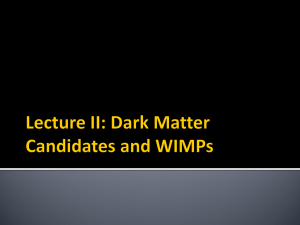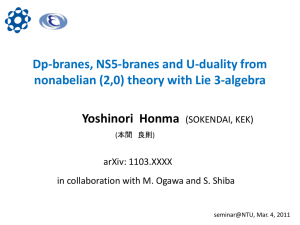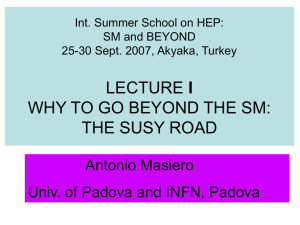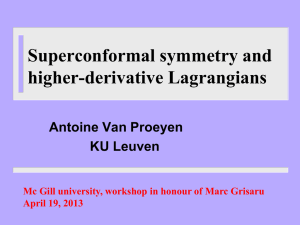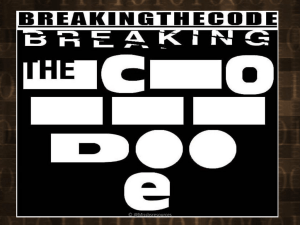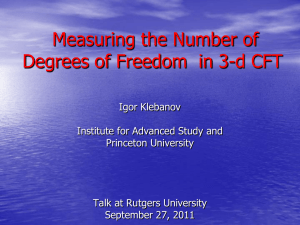My talk at NTU on 12/08 `10
advertisement
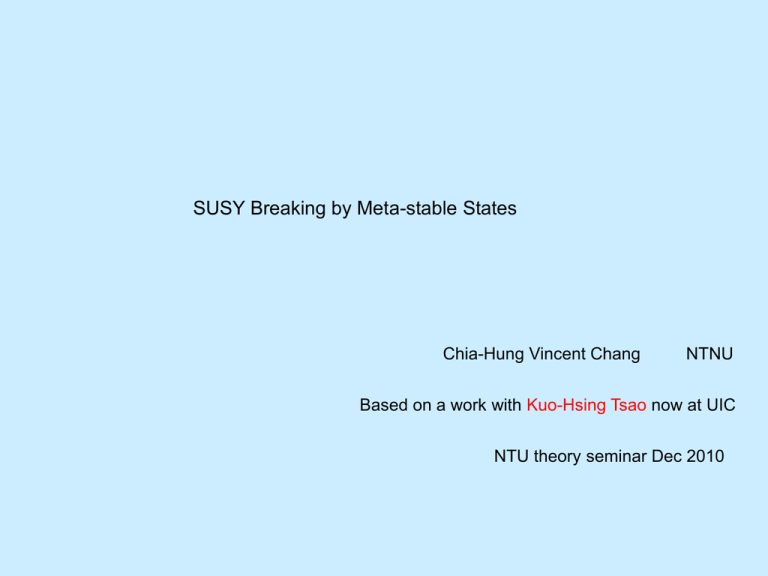
SUSY Breaking by Meta-stable States Chia-Hung Vincent Chang NTNU Based on a work with Kuo-Hsing Tsao now at UIC NTU theory seminar Dec 2010 Modernism in Architecture Architecture is about building a residence. A residence is supposed to project a feeling of home, stable, stationary, you stay forever once you reach there. No matter how high reaching the building is, it always has a stable ground structure to anchor its excitation. even a skyscraper…… There are exceptions, but mostly accidental….. This stable home feeling ground structure is very similar to the ground state in modern physics! Excited system always come back to the stable ground state and stay there unless excited again. The ground state is where the world resides. We think the structure of the stable ground state will determine how our daily world looks like! But…. In this ever-changing world, do we really need to stay at a stable home all the time? First the architectures of modernism allow it to flow….. then they are giving up the restrictions of stability …….. Rødovre, near Copenhagen, Denmark and start searching for the excitement of the freedom to stay ……… semi-stable Capital Gate tower of Abu Dhabi , 18 degree lean (4 times that of the Leaning Tower of Pisa) The contrast between the stabilty of a classical building and the freedom of a modern structure can be captured here. Luckenwalde Town Library (D) near Berlin The thing is If the architectures, who are supposed to know how to reside better than we do, have actually …… moved on, to give up total stabilty. Maybe it is also time for us physcists to appreciate the thrill and the ecstasy of being semi-stable. Breaking of Supersymmetry by being semi-stable. SUSY Breaking by Meta-stable States Chia-Hung Vincent Chang NTNU Based on a work with Kuo-Hsing Tsao now at UIC NTU theory seminar Dec 2010 Breaking of Supersymmetry by being semi-stable. Breaking of Supersymmetry by Metastable States. Contents 1. 2. 3. 4. 5. 6. 7. 8. Fast SUSY primer SUSY breaking O’Raifeartaigh Model Why breaking SUSY is highly restricted The ISS proposal Matastable SUSY breaking Dienes’ and Thomas’ idea to realize ISS at tree level Our simplification of D & T Summary The difference between them is artificial. Symmetry Boson Fermion What’s the motivation? Quadratic Divergence m 2 1 4 d k k 2 M m H m 0 c 2 2 2 2 2 We need a fine-tuning to get a small Higgs mass. m H SUSY forced the quadratic divergencies in the two loop diagrams to cancel. Scalar self interaction is related to Yukawa coupling. Coupling Unification String Theory Extra Space Dimension SUSY Semi-Primer The only non-trivial extension of symmetry in quantum field theory beyond Poincare symmetry and internal symmetry. This supersymmetry identifies bosons and fermions! The generators are fermionic (anticommuting, spinorial). SUSY algebra Every Boson comes with a Fermion partner, which behaves identically, and vice versa. Chiral Superfield It’s customary to organize SUSY multiplets by superfields: functions of xμ and an imaginary superspace fermionic coordinates θ. , , , 0 , 1, 2 1 2 0 2 2 Superfield can be expanded in powers of θ. The expansion terminates soon. The components are various ordinary fields in a super-multiplet. Just like in tensor analysis, you put SUSY invariant constraints on superfield to get irreducible representations. Chiral Superfield combines a scalar φ and a left-handed Weyl spinor ψ F(x) is a auxiliary field and can be solved in terms other fields by EOM. SUSY transformations can be realized as translations in the superspace θ (plus a translation in space time x). Given a function of superfield Φ :W(Φ) SUSY invariants can be obtained by integrating W(Φ) over θ. Funnily, the integration over θ acts just like differentiation with θ. d W ( ) 2 Wess-Zumino Model General renormalizable SUSY model of Chiral superfields. W ( ) 1 2 Masses of fermions m 2 1 y 3 3! Yukawa coupling between bosons and fermions W(Φ) controls interactions and masses. Superpotential Kinetic Energy term comes from: d 2 d 2 Fi 2 i As a bonus, it also gives rise to scalar interactions. Equation of Motion solves F completely: Fi V W ( i ) i Fi 2 i i For Wess-Zumino Fi m 1 2 i Scalar mass and Fermion mass are degenerate. Scalar self interaction is related to Yukawa coupling. It is this scalar potential that will determine the vacuum or vacua. 2 2 V m 2 y 1 4 y 2 4 V V Vector Superfield Vector Superfield combines a vector v and a left-handed Weyl spinor λ. In Wess-Zumino gauge: D(x) is a auxiliary field and can be solved in terms other fields by EOM. SUSY vacuum Take trace SUSY ground state has zero energy! Fi 0 Spontaneous SUSY breaking Ground state energy is the order parameter. some Fi 0 SUSY will be broken if all the auxiliary fields can not be made zero simultaneously! Another way to see it: Spontaneous SUSY Breaking implies that under SUSY transformation: The transformation of components of a chiral superfield is The only possible Lorentz invariant non-zero VEV at r.h.s. is that of F. F 0 There is a mass relation for the fields spontaneously breaking SUSY. Bosons m 2 m 2 Fermions Spontaneous SUSY breaking can’t be generated in SM or one of the squarks will be too light. SM Hidden SUSY Breaking Sector Weak Mediating Sector: Messenger The mediation control the phenomenology. Messenger could be gravity, gauge interaction (SM), anomaly etc. Messenger can include some SM gauged superfields that also doubly play a role in breaking SUSY: Direct Gauge Mediation some F-type SUSY breaking Fi 0 O’Raifeartaigh (1975) Model (OR model) There are as many F-terms as superfield. In general, there will be a solution for all the F-terms to vanish unless the superpotential is special-designed. Three chiral superfields: X , 2 , 1 W Xg 1 ( 1 ) 2 g 2 ( 1 ) FX W X g 1 ( 1 ) F 2 X,Φ2 don’t talk to each other. W 2 g 2 ( 1 ) Generically we can’t make both vanish. One of the F’s is non-zero. SUSY is borken. (Consider this as the effective field theory of a more natural UV complete theory) O’Raifeartaigh Model (OR) (1975) For a specific example, g 1 (1 ) 1 2 g 2 ( 1 ) m 1 h 1 f 2 W Xg 1 ( 1 ) 2 g 2 ( 1 ) FX F 2 W X W 2 g 1 ( 1 ) 1 2 h 1 f 2 g 2 (1 ) m 1 These two auxiliary fields are two distinct functions of just one field. They can’t be zero at the same time. We can be sure before analyzing the vacuum structure, SUSY is broken. The vacuum (vacua) of OR model minimum conditions V FX 1 2 X , h f V 2 V 1 2 F1 2 2 2 1 2 V F 2 F 0 m 1 2 hX 1 m 2 2 F1 0 1 2 2 h 1 f h 1 m 1 0 2 1 0 1 F1 hX 1 m 2 1 0 0 2 0 , X arbitrary V 1 2 2 h 1 f 1 0 2 m 1 2 hX 1 m 2 2 2 0 , X arbitrary SUSY is broken by a non-zero F. The non-SUSY vacua is not one state, but a one complex dimensional space of degenerate. Pseudo-Moduli Space of Vacua The degeneracy will be lifted by one-loop effective potential: The minimum vacuum is at X 0 X 0 At this vacuum We can calculate the masses of scalars and fermions. m s 0 , 0 , m , m , m hf , m hf 2 2 2 2 Modulus Fields m f 0, m , m SUSY breaking massless Goldstino Dynamical SUSY Breaking OR models contain scales f that is put in by hand. These scales generate SUSY breaking scale and may need fine-tuning. It is natural that we (with Witten) prefer a non-perturbative dynamic SUSY breaking mechanism where scale are generated by dynamically, just like Λ in QCD. A QCD-like SU(Nc) gauge interaction that becomes strong at a scale Λ. Some hidden chiral superfield S carry the SU(Nc) charge Just like QCD, the fermion components of S forms condensate: S S 3 This is the F component of the super-meson field It breaks SUSY at scale Λ. S S S F S This scale can be naturally small compared to cutoff scale: Just like QCD ( ) ( M cutoff ) e c ln ( ) 1 M cutoff 2 b M cutoff M cutoff Coupling Constant α doesn’t need to be fine-tuned to generate a large hierarchy. On the other hand, FI and OR seems to emerge as the low energy effective theory of a dynamical SUSY breaking mechanism. Unfortunately, it doesn’t work! Witten Index (1982) Tr ( 1) F n B ( E ) n F ( E ) n B (0) n F (0) E Every bosonic state of non-vanishing energy pair with a fermionic state. If the Witten index is non-zero, there must be a state with zero energy and hence SUSY is unbroken! Tr ( 1) F 0 SUSY is unbroken. (The reverse is not true.) Witten index is invariant under changes of the Hamiltonian that do not change the far away behavior of the potential! Witten index is invariant under changes of the Hamiltonian that do not change the far away behavior of the potential! It is possible to calculate Witten index at weak coupling while applying the conclusion to strong coupling. Witten index is non-zero for pure SUSY Yang-Mills theory. Gauge theories with massive vector-like matter, which flows to pure Yang-Mills at low energy, will also have a non-zero Witten indices. Tr ( 1) F 0 SUSY is unbroken. For these two theories, SUSY is unbroken. SUSY QCD just isn’t like QCD. There is a stable supersymmetric vacuum. S S 0 Four requirements for dynamical SUSY breaking Chiral Matter A non-perturbative superpotential generated over the classical moduli space A tree level superpotential which completely lifts the classical moduli space U(1)R symmetry (3,2) model by Affleck, Dine and Seiberg (1984) It contains an U(1)R symmetry. U(1)R symmetry Affleck, Dine and Seiberg Model has an unbroken U(1)R symmetry. This is a serious problem. U (1) R : charge - 1 Boson and its superpartner have opposite charges. Superpotential W needs to be charge 2 to preserve U(1)R d 2 W ( ) O’Raifeartaigh Model (OR) also has a un unbroken U(1)R symmetry. The R charges of the three chiral superfields: R ( X ) R ( 2 ) 2 , R ( 1 ) 0 W Xg 1 ( 1 ) 2 g 2 ( 1 ) is charge 2. Generically it can be proven (Nelson and Seiberg 1994): U (1) R SUSY Breaking U (1) R SUSY Vacuum Vacuum An unbroken U(1)R symmetry will prohibit Majorana gaugino masses (R invariant) and render model-building very difficult. SUSY breaking seems to be a rather non-generic phenomenon. “The issue of SUSY breaking by ground state has a topological nature: it depends only on asymptotics and global properties of the theory.” Breaking it by ground state will require an unbearable price. It is really a Fearful Symmetry! Tony Zee Enters Meta-Stable Vacua ISS Model A supersymmetric SU(Nc) gauge theory with Nf fundamental and anti-fundamental chiral superfields Q i , Q i W mQ i Q i The vacuum is supersymmetric. Nc 1 N f 3 2 Nc m It has a magnetic dual, IR free with a low energy effective theory: W h tr ~ tr m It could be calculated that there is a metastable SUSY breaking vacuum far away from the true vacuum: Q Q m 2 Its property can be illustrated by a similer low energy effective theory: OR model. Modify OR model by adding a small mass term for φ2 (Deformation) 1 FX 1 2 h 1 f 2 F 2 m 1 m 2 F1 hX 1 m 2 Now 3 equations for 3 unknowns, a solution can be found: This is a SUSY vacuum. U(1)R has been broken by the small mass term as expected. R ( X ) R ( 2 ) 2 , R ( 1 ) 0 For small mass, the potential near the previous SUSY breaking minimum is not greatly modified. 1 0 2 0 , X 0 It will still be locally stable. Hence it becomes a metastable vacuum! The universe can live in the metastable vacua with SUSY broken. Globally, there is a SUSY vacuum, hence ensuring U(1)R is broken. Using metastable state to break SUSY while keeping a SUSY ground state could help evade a lot of constraints such as Witten Index. “Breaking SUSY by long-living metastable states is generic.” Intrilligator, Seiberg, Shih (2006) At A, At B, 1 0 2 0 , X 0 Metastable state breaking SUSY As ε becomes smaller, SUSY vacuum A will be pushed further and further, diminishing the tunneling rate as small as you like, until disappear into infinity at ε=0. With a SUSY vacuum, R symmetry is explicitly broken and gaugino masses are generated. However the small parameter also render the gaugino masses very small. Try the idea of metastable SUSY breaking by a new mechanism. V V Vector Superfield Vector Superfield combines a vector v and a left-handed Weyl spinor λ. In Wess-Zumino gauge: D(x) is a auxiliary field and can be solved in terms other fields by EOM. The most general supersymmetric Lagrangian of a vector superfield 1 D 2 a In the presence of a chiral field, we can solve the auxiliary D D a g i T ij a It gives a scalar potential V 1 2 a 2 Da j 2 a Under SUSY, F and D change by a total divergence. For Abelien gauge theory, the D term of a vector superfield is both gauge invariant and supersymmetric. We can add a D-term to the Lagrangian: kD Fayet-Iliopoulos Term In the presence of matter, we can solve the auxiliary D D g i i i k Put everything together: with the all (and the only) important scalar potential: SUSY vacuum SUSY ground state has zero energy! Fi 0 , D0 Spontaneous SUSY breaking Ground state energy is the order parameter. Fi 0 , or D0 SUSY will be broken if all the auxiliary fields can not be made zero simultaneously! Another way to see it: Spontaneous SUSY Breaking implies that under SUSY transformation: The transformation of components of a chiral superfield is The only possible Lorentz invariant non-zero VEV at r.h.s. is that of F. F 0 Similar for vector superfield: D 0 D-type SUSY breaking Fayet-Illiopoulos mechanism (1974) Assuming an Abelien Gauge Theory: Two Chiral Superfield Q, Q with opposite charge +1, -1 Introduce a non-zero mass for Q: W mQ Q and a non-zero FI term k for the Abelien gauge theory. D Q Q Q Q k The scalar potential: V mQ 2 mQ 2 1 2 Q Q Q Q k 8 If m is large, the minimum is at Q Q 0 U(1) gauge symmetry is unbroken. D k 0, V 1 k 0 2 At this vacuum: 8 SUSY is broken by a non-zero D term. If mass is small m 2 k the minimum of V is at Q 0, Q v with v m k 2 2 SUSY is broken by non-zero D term and F terms. U(1) gauge symmetry is now broken We expect a massive gauge boson and massless goldstino (mixture of gaugino and fermionic component of Q) of SUSY breaking. Try the idea of metastable SUSY breaking by D type model. Dienes and Thomas Model nest Achieve a SUSY breaking metastable state perturbatively (tree level calculation). The recipe is to put a Wess-Zumino and a Fayet-Illiopoulos together! Three Chiral Superfields 1 , 2 , 3 A Wess-Zumino Superpotential W 1 2 3 Two Abelien U(1) with FI terms: U (1) a , a , g a U (1) b , b , g b Massive vector matter with opposite charges in FI 4 , 5 W m 4 5 Together, you also need to assign appropriate charges to 1 , 2 , 3 The extrema are determined by the conditions: Solutions is a local minimum if the following mass matrix contains only positive eigenvalues! This is the hard part! As an example, choose A is a SUSY true vacuum, with R symmetry and a U(1) gauge symmetry. B is a SUSY breaking metastable local minimum, with broken R symmetry and broken U(1) gauge symmetry. A is a SUSY true vacuum, with R symmetry and a U(1) gauge symmetry. B is a SUSY breaking metastable local minimum, with broken R symmetry and broken U(1) gauge symmetry. This model has the benefits: It’s tree level mechanism and everything is calculable. No small parameters are needed. The metastable states are produced and sustained by the complexity of the model. Lifetime of the metastable state The metastable state tunnels to the true vacuum through instanton transition. The decay rate per unit volume is B is calculated from the distances in field space between barrier top (C) and metastable state (B) or true vacuum (A): and the potential differences between similar combinations: Under certain conditions: In the example: B 1300 This is large enough for the metastable lifetime to exceed the age of the universe. A is a SUSY true vacuum, with R symmetry and a U(1) gauge symmetry. B is a SUSY breaking metastable local minimum, with broken R symmetry and broken U(1) gauge symmetry. This model has the benefits: No small parameters are needed. The metastable states are produced and sustained by the complexity of the model. How complicated are we required to be? Our Model I: To simplify Dienes & Thomas Model We throw away U(1)b As an example: We again find structures of minima: B A The metastable minimum is a bit shallow! It will decrease the lifetime of B, but it turns out still OK. B Our Model II: we simplify our Model I even further: We throw away one superfield and U(1)b As an example: We again find structures of minima: A B 3 A C B 1 C B A We have constructed a model which is one field and one Abelien Gauge symmetry short of the Dienes Thomas Model, but achieves the same ground state structure. The metastable local minimum is about as deep in DT and the distance between A,B is also about the same order. We expect the lifetime of metastable to exceed the age of the universe. How about a model without mass terms? Summary 1. 2. 3. 4. Breaking SUSY by metastable states and allowing at the same time a SUSY vacuum let model building escape from the stringent constraints posed by the global nature of SUSY breaking. It becomes generic and easy to build. This proposal can be realized at the tree level as suggested by Dienes and Thomas, in a beautiful combination of WessZumino model and Fayet-Illiopoulos Model. Both F-term and D-term acquire non-zero VEV at the metastable local minimum. We simplify this model by reducing the number of U(1) gauge symmetry and superfield and find it works as in DT. Further clarification of why they work and the essence of DT’s proposal is still under investigation.


